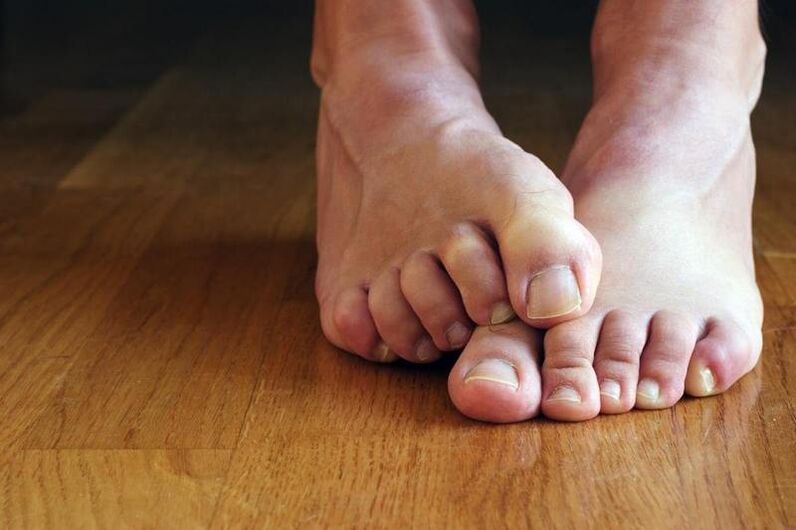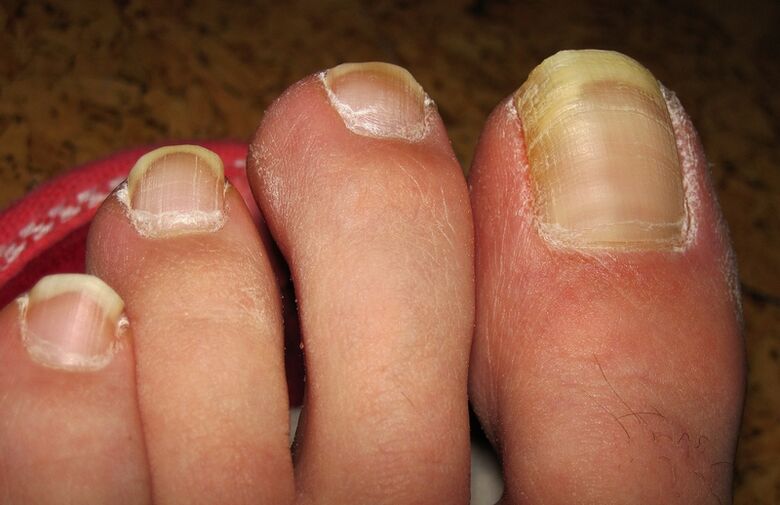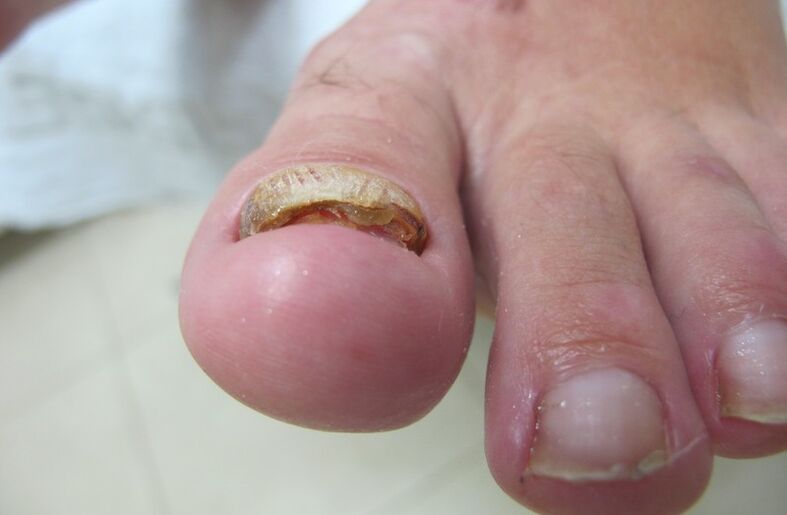Mycosis of the toenails is fairly common in humans. In addition to adverse cosmetic effects, these infections can cause significant damage to the body, so onychomycosis must be treated. But for that, you need to learn as much as possible about the disease, especially since scientists have identified a large number of types of pathogens today.
Pathogen type
With onychomycosis, the parasite begins in the structure of the nail tissue and the skin around them. According to generally accepted classifications, the spore microbes that can manifest in the human body are divided into three groups:
- Yeast nail fungi, mainly Candida albicans;
- Dermatophyte fungi (Trichophyton, Microsporum and Epidermophyton);
- Mold species (Aspergillus, Alternaria and Fusarium).
Acute or chronic onychomycosis causes each of them, respectively. Simultaneous infection of two or, more rarely, three of these species is not uncommon. Accurate detection of pathogens is extremely important in the diagnostic process because each group of fungal diseases can be treated with different drugs, which are not universal.

Reason for appearing
The cause of infection may be related to the entry of pathogens from the external environment or to the general condition of the patient's body. Their knowledge will help you understand how to treat nail fungus.
External sources of fungal spread include:
- Swimming pools, changing rooms, showers, bathtubs - public spaces where people walk barefoot. Therefore, when visiting such venues, slippers should be worn for safety.
- The use of poorly sterilized tools in salons during pedicures is often dangerous to the body.
- Other people's papers, scissors and other products used for personal hygiene pose no small threat.
- In summer, closed shoes can be dangerous and feet sweat a lot.
- In order not to treat onychomycosis of the nails, you should take regular baths or showers, as sweat and dirt are a favorable environment for bacteria.
- Some types of onychomycosis are spread by pets, but these pathogens are mostly common in hot countries.
Other health problems also contribute to the development of the disease:
- Weakened immune system.
- Small cuts and cracks in the skin, dry tissue.
- Lots of glitches.
- Violation of blood circulation in the nail tissue.
- Exposure to fungal pathogens from human skin. This method of infection is called autoinfection.
Therefore, there are many sources of infection of fungal diseases. These microorganisms are so common around the world that many people suffer from diseases such as nail fungus. So knowing how to treat onychomycosis is never superfluous.
Symptoms and Diagnosis
The presence of fungus on the legs does not imply the inevitable development of the disease. Onychomycosis only occurs in people with weakened immune systems. But there are many options for how toenail fungus manifests. In this case, pay attention to the following symptoms of nail fungus:
- compacting or reducing the thickness of the stratum corneum;
- high brittleness of the nail plate, delamination;
- the presence of burrs and calluses;
- Unnatural colors: white, yellow or green;
- The roughness of the nail plate surface;
- loss of natural luster;
- Inflamed skin of fingers, itchy feet;
- Cracked feet.

With these signs, you can understand how toenail fungus started.
Treatment of advanced toenail fungus is difficult and lengthy. This is why onychomycosis symptoms cannot be ignored. If you notice them, you should seek medical help right away.
The primary goal of diagnosing nail fungus is to accurately identify the causative agent of the infection. Many types of parasites are extremely difficult to detect, especially since external signs of disease can easily be confused with metabolic disorders.
In general, the diagnosis of onychomycosis is divided into several stages, for which toenail fungus is identified using the following methods:
- Clinical data research;
- analyze a piece of tissue under a microscope;
- cultural diagnosis;
- DNA research.
During the examination of the patient at the first appointment, the doctor can diagnose whether there is damage to the nail plate, but without accurate research it is impossible to understand what is causing the disease. Laboratory research is the only way to identify nail fungus.
By examining scratches under a microscope, your doctor can tell you exactly what toenail fungus looks like. The difficulty lies in identifying the specific type of pathogen. Therefore, at this stage, the diagnosis does not stop.
The exact fungal culture is determined by its propagation in the laboratory. For this purpose, nail fungi based on a special Sabouraud nutrient medium were analyzed. Usually, after three to five days of such studies, experts are able to determine the specific type of pathogen. Additionally, using this method, you can examine the parasite's susceptibility to drugs and outline the most effective course of treatment.

Parasite DNA testing is the current and most promising option for identifying toenail fungus, reducing the time it takes to get results to a day or two. However, this analysis of nail fungi was only effective in detecting yeast species.
who is at risk
As mentioned earlier, certain categories of people are susceptible to onychomycosis to varying degrees. The following are the main factors that increase the likelihood of infection:
- reach retirement age. The disease is more common in older adults than in other populations due to reduced blood circulation and worsening metabolism. Late diagnosis also plays a big role here, as pensioners who spot symptoms of nail fungus and see it as a common sign of aging don't always seek qualified help.
- Mechanical damage to nail tissue. Any damage can compromise the nutrient supply to the tissue. As a result, the focal point of the infection will start at the site of the break or crack, then spread throughout the nail, or even simply fly out of it.
- High blood sugar levels can damage the blood vessels in the feet. Therefore, the manifestations of onychomycosis are very common in diabetic patients, and they are also difficult to get rid of.
- For exactly the same reasons, circulatory disorders, such as Raynaud's syndrome or varicose veins, can lead to infections.
- Because spores are most often able to multiply on nail tissue and on body surfaces, people affected by fungal skin infections are at risk for onychomycosis. Once defeated, the disease may reappear.

The dangers of ignoring symptoms
Many people don't seek medical help if they see signs of a fungal infection, only trying to cure the advanced fungus after a while. This is due to the relatively mild course of the disease and the ability to hide cosmetic defects with socks or closed shoes.
However, you should not ignore the initial symptoms and treatment of the disease, or serious complications may occur.
If you're asking yourself why toenail fungus is dangerous, you should start with the fact that onychomycosis is contagious. An infected person poses a threat to others.
Certain restrictions are imposed on patients with fungal infections. For example, someone with an old fungus will never get a medical certificate to enter a swimming pool.
As a parasitic disease, toenail fungus can weaken a patient's immunity and increase the likelihood of other health problems. Trying to cure nail fungus at home can turn into a more serious problem.
Stale onychomycosis can lead to serious consequences and one should be concerned about:
- Parasites can enter the circulatory system;
- Lack of treatment for toenail fungus can severely weaken the immune system;
- Spores increase allergic reactions and exacerbate chronic diseases;
- People are more prone to depression, insomnia, etc. , due to the deterioration of their general health.

This is why the first sign of toenail fungus should be to contact a clinic.
treat
Treatment of toenail fungus is based on two principles. First, the drug mechanically destroys the spores. Second, drugs can slow the parasite's response, stopping their movement and reproduction. By the way, you should think carefully before deciding on the treatment of nail fungus during pregnancy.
In medicine, use of medicines, folk remedies, laser treatment of nail fungus and medical pedicures.
Pharmaceutical products
Pharmaceutical products have a big impact. Many of these are specifically selected for specific pathogens, which further enhances the effectiveness of nail fungus treatments in children and adults. Of all the quick cures for toenail fungus, medication is the best.
To enhance the effect, a diet of nail fungus can help. It is prescribed by the attending physician.
folk remedies
Often, fighting the parasite alone will not be successful because the fungus tends to restore the spore structure. Therefore, it is most advisable to seek medical help if the first signs of illness are detected. Only a doctor can confidently advise how to get rid of nail fungus fast.
There are many folk options on how to cure toenail fungus. For example, essential oils can act as natural preservatives. The main way to treat onychomycosis at home is to put a drop of the substance on the affected area and seal it with a plaster.

Vinegar fights toenail fungus, lemon juice, and mouthwash work well too. It is not uncommon to treat toenail fungus at home with iodine or garlic. The attending physician will recommend which of these therapies is better.
An effective way to get rid of nail fungus at home is a vodka-based blend. To make it, you need to mix 200 ml of alcohol, a teaspoon of lemon juice, and a half teaspoon of potassium permanganate. Add 50ml of boiled water to the composition and put it in the refrigerator for 3-5 days. With the resulting remedy, you need to wipe the affected area twice a day, in the morning and before bed, until the infection is completely gone. This help has a restorative effect, although it will take some time for the damaged tissue to recover.
All of these ingredients are included in the main list of nail fungus fears. How to get rid of fungus the quickest, a dermatologist or mycologist will tell you.
Laser Treatment
Recently, laser technology has been added to the main method of removing toenail fungus. The principle behind the treatment of nail fungus with a laser is the thermal effect of the light beam on the parasite. It produces a temperature of about 50 degrees, which by the way is the answer to the question: at what temperature does the fungus die. At the same time, the treatment of fungal diseases with short-term radiation did not have any effect on the human body.
Complex laser treatments usually consist of four sessions spaced one week apart. The competent specialists at the medical centers that offer this type of service know how to properly treat advanced toenail fungus with radiation. After laser treatment, about 85% of patients eventually recovered. This is one of the most effective ways to deal with nail fungus.
medical pedicure
You can perform a medical pedicure on nail fungus in the early stages of the disease, which is the main disadvantage of this method, in addition, the treatment of onychomycosis with nail polish is very long. Therapeutic pedicure for nail fungus involves the use of a special formula applied to the damaged area. Many beauty salons offer this service. However, you can treat nail fungus at home with the help of a medical varnish.
By the way, experts probably know how to restore nails after a fungal infection.
prevention
There are many ways to prevent fungal nail disease:
- The most important thing is daily hygiene.
- In public places, swimming pools, saunas, changing rooms, slippers should be worn.
- Do not wear closed shoes in hot weather.
- To avoid getting the fungus, do not use other people's personal hygiene items: nail files, scissors, towels, etc.
It's important to make sure your child follows these rules clearly.
There are different types of fungal toenail infections. Treatment of onychomycosis requires careful diagnosis, long-term treatment, and may require certain funds. Therefore, it is best to follow precautions to prevent infection with parasites. Knowing how to beat fungi isn't superfluous either.
















